Leaf Feeders
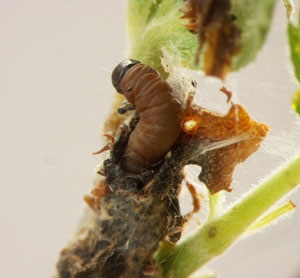
Copyright © 2018 John van der Linden, bugguide.net, used with permission
The Leaf crumpler larva is around an inch long, with a green-grey color with purple markings at each segment. The adult is a small moth with brown and white stripes along its wings. The caterpillars build web tubes on twigs which incorporate leaf fragments as they feed. The tube can be 1.5-2 inches long by the time the caterpillar is mature. Damage and nests are at their peak in July and August.
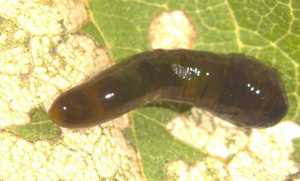
Lesley Ingram, Bugwood.org
The name, Pear slug, is a misnomer; these are not true slugs but sawfly larvae. The shiny, green to orange larvae can be up to a half inch long and feed by skeletonizing leaves. Larvae feed on the lower surface of pear, cherry and plum. There are two generations per year with overwintering occurring as a pupa. Adults emerge in early summer and lay eggs which mature, pupate and emerge as adults by August-September. New larvae from the summer generation will feed then pupate for the winter.
Sap Feeders
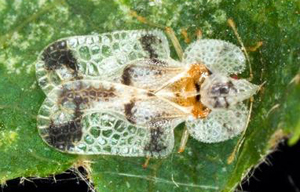
David Cappaert, Bugwood.org
Lace bugs are flat gray sap-feeding insects with clear, ornate, lacy wings; nymphs are spiny and wingless. Both stages live on the lower surface of leaves. As they feed, they leave tiny yellow to white spots on leaves and dark, varnish-like waste spots on the under sides. These lace bugs spend the winter as eggs under bark or in leaf litter. The eggs hatch in early spring and the nymphs begin to feed on plant sap. There are several generations each season. Initially, numbers are so small that feeding symptoms are not noticed until the population peaks in late summer. When abundant, feeding can make plants unsightly and may cause premature leaf drop.
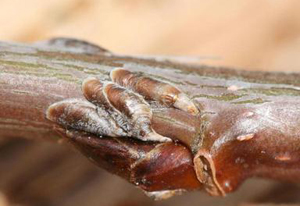
Whitney Cranshaw, Colorado State University, Bugwood.org
Oystershell scales are about 1/10 inch long and resemble crusty accumulations of oyster shells on the bark. Their drab, bark-like appearance makes them easy to overlook, even on close inspection. Heavy infestations can kill twigs or branches. This scale overwinters in the egg stage under the waxy covering of the female. The eggs hatch and the crawlers are active from late May to early June.
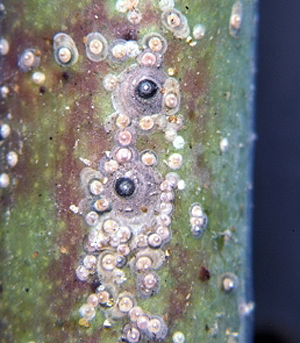
United States National Collection of Scale Insects Photographs,
USDA Agricultural Research Service, Bugwood.org
San Jose scale is one of the most destructive scale species. Infested stems, twigs or branches may be killed and heavily infested trees may die. These small circular brown armored scales have a series of dark concentric rings on their waxy covering. There are several generations each year. First crawlers are active from late May to early June, a second generation appears in late July and a third in late summer or early fall. Heavily infested plants may have a crusty covering of scales.
Borers
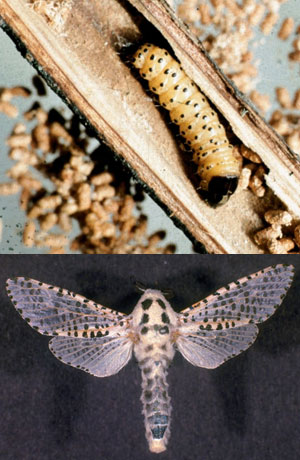
Petr Kapitola, Central Institute for Supervising and Testing in Agriculture,
Bugwood.org (larva);James Solomon, USDA Forest Service, Bugwood.org (adult)
Both the caterpillar and adult of the Wood leopard moth are very distinctive. The caterpillar is the damaging stage, feeding under the bark of host trees. It is a white-orange color with numerous spots on its body. The adult is white with six black dots on the thorax and black markings on the remainder of the body. Adults may be active June-September and larvae feed inside of plants for 2-3 years.